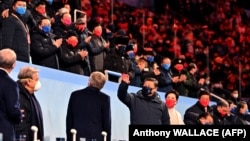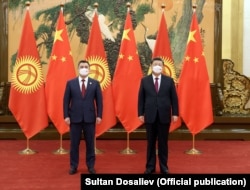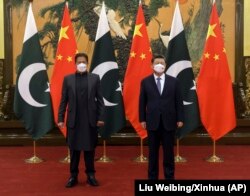After not holding in-person meetings with foreign leaders for two years due to the coronavirus pandemic, Chinese President Xi Jinping engaged in a flurry of face-to-face diplomacy on the sidelines of the Winter Olympics as China looked to project its rising global status.
Despite a “diplomatic boycott” from many Western nations over Chinese human rights abuses, 22 world leaders attended the open ceremony in Beijing on February 4.
Many represented autocratic nations, with leaders from Kazakhstan, Tajikistan, Turkmenistan, and Uzbekistan sending leaders to meet with Xi, along with delegations from other nondemocratic countries such as Egypt, Saudi Arabia, Qatar, and the United Arab Emirates. The leaders of Kyrgyzstan, Pakistan, and Serbia also went to Beijing.
For visiting dignitaries, the diplomatic possibilities on the sidelines of the Olympics were a rare opportunity to meet face-to-face with Xi and other senior Chinese officials, with many arriving with high-level delegations to try and invigorate relations with China and kick-start various initiatives derailed due to the pandemic.
The most high-profile meeting came in the form of a summit between Xi and Russian President Vladimir Putin in a choreographed showing of solidarity between the two leaders amid Moscow’s tensions with Ukraine that threaten turning into a war.
Beijing and Moscow announced a new gas deal, with the Kremlin promising to increase its exports at a time when Putin is at odds with European customers. In a joint statement after they met, the two leaders said their friendship had “no limits,” and China sided with Russia on its security demand that NATO put a moratorium on an eastward expansion.
The meeting with Putin concluded shortly before the Olympics’ opening ceremony in Beijing's National Stadium, and both events amounted to a display of China’s newfound place in the world as it looks to shore up its own partnerships, win over countries, and push back against what Chinese officials view as Western pressure to impede its rise.
“Russia and China stand against attempts by external forces to undermine security and stability in their common adjacent regions,” Putin and Xi said in the 5,300-word joint statement.
Seeking Face Time
While Putin and Xi put warming ties between China and Russia on display, no other region in the world was better represented diplomatically at the opening ceremony than Central Asia, with its five presidents eager to boost ties with China, the region’s main source of trade and investment.
Kazakh President Qasym-Zhomart Toqaev met with Xi for the first time since unrest rocked the country in January and the Chinese leader said ties between the two countries had “reached beyond the boundary of bilateral relations.”
But perhaps the Central Asian leader with the most on the line was Kyrgyz President Sadyr Japarov, who was keen to make progress on the long-stalled China-Kyrgyzstan-Uzbekistan railway.
During a January 25 virtual summit between the five Central Asian leaders and Xi, Japarov said the railway could be “a flagship project of the Belt and Road Initiative (BRI),” Beijing’s global foreign policy venture, and that he was heading to Beijing with new contracts and a financing plan, RFE/RL’s Kyrgyz Service reported.
Japarov, however, failed to gain traction for the railway during his February 6 meeting with Xi despite Uzbek President Shavkat Mirziyoev also pushing the project during his talks with the Chinese leader.
According to the Chinese readout of their meeting, Beijing asked that Kyrgyzstan first improve the country’s business climate before it green-lighted the project.
Besides the railway, Japarov also discussed other investment and cooperation possibilities, even proposing that Kyrgyzstan could begin to export electricity to western China.
Tajik President Emomali Rahmon and Turkmen President Gurbanguly Berdymukhammedov both came to Beijing with more modest expectations and neither left totally empty-handed.
Berdymukhammedov, who went to Beijing despite Turkmenistan not sending any athletes to the Olympics, gave a rare interview to China's state-run CCTV news agency in which he praised Xi’s leadership, discussed Ashgabat’s neutrality, and reaffirmed Turkmenistan’s adherence to the One China policy, which does not recognize Taiwan’s status as an independent entity from mainland China.
While the Turkmen leader left with few deliverables, he also raised a long-delayed project of his own: a new natural gas pipeline to transport more gas across Central Asia to China known as Line D.
While Turkmenistan is eager to increase its exports, many analysts contend the project is unlikely to gain momentum in the next decade when a substantial increase in Chinese demand is predicted.
In addition to requisite face time and a photo op with Xi, Rahmon also inked a joint economic and trade cooperation plan with China through 2025 during his February 5 meeting.
'Ironclad'
The chance to meet with Xi in person was also an important opportunity for two leaders close to Beijing that were eager to breathe new life into their established partnerships with China: Serbian President Aleksandar Vucic and Pakistani Prime Minister Imran Khan.
Vucic met with Xi on February 5, with the leaders referring to their country’s relations as an “ironclad” friendship, a level of rhetoric that Beijing reserves only for its closest partners.
Under Vucic, Serbia has steadily deepened its ties with China in trade, technology, and defense. While the partnership has changed quickly, Belgrade also maintains a foreign policy that looks to balance its relations with Beijing off the European Union, Russia, and the United States.
The Serbian president appeared to strengthen his hand during the trip to China, leaving with an array of economic and political deals, such as a fast-tracked, free-trade agreement, new investments, and the introduction of direct flights from Belgrade to Shanghai and Beijing.
Khan was also looking to reaffirm Pakistan's “all-weather” friendship with China during his February 6 meeting with Xi.
Beijing and Islamabad have a storied relationship and Pakistan has been one of China’s most enthusiastic partners on the BRI, with the $62 billion China-Pakistan Economic Corridor (CPEC) project becoming a centerpiece of the massive infrastructure initiative.
But the CPEC’s progress has been patchy for several years and the combination of the pandemic and a series of attacks on Chinese workers across Pakistan in the summer of 2021 have slowed things down further and become a sore spot in relations between Beijing and Islamabad, despite their rosy public rhetoric.
Khan left Beijing without any new agreements and instead used his visit to discuss his country’s long-standing ties with China.
“Pakistan and China not only see each other as iron brothers,” Khan told China’s state-run Global Times during a February 5 interview, “but they also think that the China and Pakistan relationship is as high as the Himalayas.”














